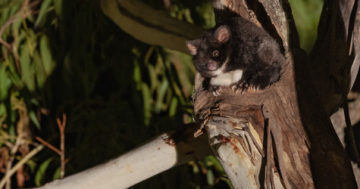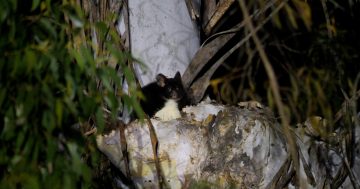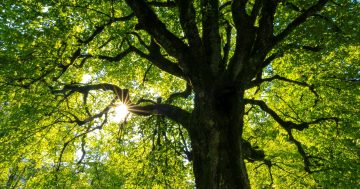
A greater glider spotted in Tallaganda State Forest. Photo: World Wide Fund for Nature-Australia.
Conservation groups are claiming NSW’s forestry body has breached a rule designed to protect endangered greater gliders 188 times in state forests.
These groups are demanding the NSW Environment Protection Authority (EPA) issue stop work orders in several state forests, including Flat Rock, Clyde, Currowan, Shallow Crossing and Bondo in the South East, after allegedly finding Forestry Corporation of NSW (FCNSW) had not been complying with survey requirements for glider den trees.
WWF-Australia said Forestry had to search for den trees and protect them with a 50-metre exclusion zone where logging is banned. These trees must be identified by witnessing a glider entering or leaving a hollow.
South East Forest Rescue (SEFR) conducted a desktop audit of searches held after 16 February by reviewing data available on the Native Forestry Map Viewer.
After 243 transect searches, 261 gliders were sighted, but only nine den trees and four potential den trees were identified.
“This indicates dens were only identified for five per cent of gliders seen in the areas searched. The vast majority of greater glider dens were missed and not protected with the legally required 50-metre exclusion zones,” WWF-Australia claimed.
“This poor result is because Forestry Corp started 188 (77 per cent) of their searches more than an hour after dark when greater gliders had already left their dens for the night.
“These searches breach the rule that transects must commence ‘no more than one hour after sunset local time.'”
North East Forest Alliance spokesperson Dailan Pugh said it was clear the rules were not providing greater glider homes with the protection they needed.
“If we want to save greater gliders from extinction it is essential we protect most of their dens and feed trees within their home ranges by placing 100-metre exclusions around all sightings,” he said.
WWF-Australia conservation scientist Dr Kita Ashman said a 100-metre exclusion zone would allow surveys to be conducted through the night.
“Establishing 100-metre exclusion zones would give gliders space to feed, socially interact, and safely move through habitat,” she said.

This greater glider was apparently sighted in Flat Rock State Forest on 26 January. Photo: South East Forest Rescue.
SEFR spokesperson Scott Daines said Forestry’s alleged behaviour was “outrageous”.
“Once again we’re doing the EPA’s work by exposing these botched searches as time is running out to save greater gliders,” he said.
The EPA was asked whether it was considering imposing stop work orders in the abovementioned state forests.
“The NSW Environment Protection Authority (EPA) is continuing to investigate the matters raised by the conservation groups around glider surveys conducted by Forestry Corporation NSW,” an EPA spokesperson told Region.
A spokesperson for Forestry Corporation said it was always their intention to apply the rules. Also, since the site-specific biodiversity condition came into effect in February, it had been working closely with the regulator on implementing these new rules.
“That has included sharing all search and survey data with the EPA over this time,” the Forestry spokesperson said.
“We have just received SEFR’s letter, are reviewing it and will engage with the EPA.”
The debate over the protection of greater gliders in South East NSW came to a head in 2023, when the EPA ordered FCNSW to halt operations in parts of Tallaganda State Forest that August, after officers found a dead glider near harvest operations.
The order was extended until 13 November, but that deadline shifted yet again for another 40 days to 20 December.
In the meantime, activists called for urgent reforms after 89 endangered greater gliders and 20 habitat trees were found in areas of the forest that had been earmarked for logging.
In January, Forestry was ordered to pay a fine and legal costs totalling $104,000 after it illegally took down protected trees in Mogo State Forest.
Earlier this year the EPA backflipped over a rule to do with the protection of the gliders. On 2 February, it announced it would remove the requirement for Forestry to search for greater glider den trees, before reintroducing this requirement on 16 February.
In March Forestry was fined $45,000 for two incidents of tree removal, including in Nadgee State Forest on the Far South Coast.















